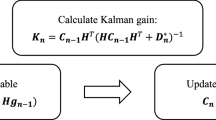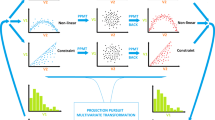Abstract
The objective of the work presented in this paper is to provide a quantitative measure of grade heterogeneity at the selective mining unit scale within relatively large estimated resource blocks. The purpose of the work is to provide a means of evaluating the potential for selectively mining a resource block and thereby maximising recovery and minimising the processing of waste. Such a measure is effectively a downscaling of the geostatistically estimated heterogeneity at the resource block scale to that of the selective mining unit scale. The major challenge in modelling and predicting heterogeneity at this scale is that the degree of heterogeneity is a function of scale, where sample density usually limits estimation and prediction to spatial dependence approaches, namely those based on the concept that the similarity of grades depends on the (directional) distance that separates them. This work extends the concept of grade heterogeneity to include the degree of clustering of different classes of attribute values. A heterogeneity index based on these clusters provides a quantitative measure of the heterogeneity of these classes. Three synthetic case studies, based on a real mining operation, are used to evaluate the performances of various approaches. Of the methods evaluated, the local conditional simulation approach is the most suitable method for estimating the heterogeneity index.










Similar content being viewed by others
References
Abzalov MZ (2006) Localised uniform conditioning (LUC): a new approach for direct modelling of small blocks. Math Geol 38(4):393–411
Adeli A, Emery X (2021) Geostatistical simulation of rock physical and geochemical properties with spatial filtering and its application to predictive geological mapping. J Geochem Explor 220, ISSN 0375-6742
Adeli A, Emery X, Dowd P (2018) Geological modelling and validation of geological interpretations via simulation and classification of quantitative covariates. Minerals 8(1):7
Altieri L, Cocchi D, Roli G (2019) Measuring heterogeneity in urban expansion via spatial entropy. Environmetrics 30(2):e2548
Anselin L (1995) Local indicators of spatial association—LISA. Geograph Anal 27(2):93–115
Batty M (1974) Spatial entropy. Geograph Anal 6(1):1–31
Benndorf J, Jansen JD (2017) Recent developments in closed-loop approaches for real-time mining and petroleum extraction. Math Geosci 49(3):277–306
Bianchi M, Pedretti D (2017) Geological entropy and solute transport in heterogeneous porous media. Water Resour Res 53(6):4691–4708
Bianchi M, Pedretti D (2018) An entrogram-based approach to describe spatial heterogeneity with applications to solute transport in porous media. Water Resour Res 54(7):4432–4448
Bonett DG (2006) Confidence interval for a coefficient of quartile variation. Comput Stat Data Anal 50(11):2953–2957
Bourgault G, Marcotte D, Legendre P (1992) The multivariate (co)variogram as a spatial weighting function in classification methods. Math Geol 24(5):463–478
Carrasco C, Keeney L, Napier-Munn TJ, Bode P (2017) Unlocking additional value by optimising comminution strategies to process Grade Engineering® streams. Miner Eng 103–104:2–10
Carrasco C, Keeney L, Walters SG (2016) Development of a novel methodology to characterise preferential grade by size deportment and its operational significance. Miner Eng 91:100–107
Chakravorty S (1995) Identifying crime clusters: the spatial principles. Middle States Geogr 28:53–58
Cheng Q (2012) Multiplicative cascade processes and information integration for predictive mapping. Nonlinear Process Geophys 19(1):57–68
Claramunt C (2005) A spatial form of diversity. pp 218–231
Davis MW (1987) Production of conditional simulations via the LU triangular decomposition of the covariance matrix. Math Geol 19(2):91–98
Dominy SC, O’Connor L, Parbhakar-Fox A, Glass HJ, Purevgerel S (2018) Geometallurgy—a route to more resilient mine operations. Minerals 8(560)
Dowd P (1991) A review of recent developments in geostatistics. Comput Geosci 17(10):1481–1500
Dowd P (1996) Bjorkdal gold-mining project, northern Sweden. Int J Rock Mech Min Sci Geomech Abstracts 33(7):313A
Dowd P (1997) Geostatistical characterization of three-dimensional spatial heterogeneity of rock properties at Sellafield. Trans Inst Min Metall Sect A Min Ind 106:A133–A147
Dutilleul P, Legendre P (1993) Spatial heterogeneity against heteroscedasticity: an ecological paradigm versus a statistical concept. Oikos 66(1):152–171
Espejel CD, Scott M, Nehring M (2017) Economic benefits and technical complexities of grade engineering® in strategic mine planning of metalliferous projects. In: Proceedings, 2017 international conference on mine planning and equipment selection, pp 189–197
Fouedjio F (2016a) A clustering approach for discovering intrinsic clusters in multivariate geostatistical data. In: Machine learning and data mining in pattern recognition, volume 9729, ISBN 978-3-319-41919-0, pp 491–500
Fouedjio F (2016b) A hierarchical clustering method for multivariate geostatistical data. Spatial Stat 18:333–351
Getis A, Ord JK (1992) The analysis of spatial association by use of distance statistics. Geogr Anal 24(3):189–206
Guardiano FB, Srivastava RM (1993) Multivariate geostatistics: beyond bivariate moments. In: Geostatistics Troia’92. Springer, pp 133–144
Guillot G, Kan-King-Yu D, Michelin J, Huet P (2006) Inference of a hidden spatial tessellation from multivariate data: application to the delineation of homogeneous regions in an agricultural field. J R Stat Soc: Ser C: Appl Stat 55(3):407–430
Kumral M (2010) Robust stochastic mine production scheduling. Eng Optim 42(6):567–579
Kumral M (2011) Incorporating geo-metallurgical information into mine production scheduling. J Oper Res Soc 62(1):60–68
Li H, Reynolds JF (1995) On definition and quantification of heterogeneity. Oikos 73(2):280–284
Li Y, Sepúlveda E, Xu C, Dowd P (2021) A rapid updating method to predict grade heterogeneity at smaller scales. Math Geosci pp 1–24
Lin J (1991) Divergence measures based on the Shannon entropy. IEEE Trans Inf Theory 37(1):145–151
Maleki M, Emery X (2014) Joint simulation of grade and rock type in a stratabound copper deposit. Math Geosci pp 1–25
Neufeld C, Deutsch CV (1987) Calculating recoverable reserves with uniform conditioning. Geology 2(2000):1065–1070
Neves J, Pereira MJ, Pacheco N, Soares A (2018) Updating mining resources with uncertain data. Math Geosci 51(7):905–924
Oliver MA, Webster R (1989) A geostatistical basis for spatial weighting in multivariate classification. Math Geol 21(1):15–35
Ortiz JM, Emery X (2006) Geostatistical estimation of mineral resources with soft geological boundaries: a comparative study. J South Afr Inst Min Metall 106(8):577–584
Osanloo M, Gholamnejad J, Karimi B (2008) Long-term open pit mine production planning: a review of models and algorithms. Int J Min Reclam Environ 22(1):3–35
Rivoirard J (1997) Introduction to disjunctive kriging and non-linear geostatistics. Comput Stat Data Anal 25(2):244
Rupp DE, Licznar P, Adamowski W, Léniewski M (2012) Multiplicative cascade models for fine spatial downscaling of rainfall: parameterization with rain gauge data. Hydrol Earth Syst Sci 16(3):671–684
Sepúlveda E, Dowd P, Xu C (2018) Fuzzy clustering with spatial correction and its application to geometallurgical domaining. Math Geosci 50(8):895–928
Strebelle S (2002) Conditional simulation of complex geological structures using multiple-point statistics. Math Geol 34(1):1–21
Tahmasebi P (2018) Multiple point statistics: a review. Handb Math Geosci pp 613–643
Weitzman ML (1992) On diversity. Q J Econ (May), pp 363–405
Acknowledgements
The work reported here was supported by the Co-operative Research Centre for Optimising Resource Extraction (CRC ORE) and funded as project P1-011.
Author information
Authors and Affiliations
Corresponding author
Appendix A
Appendix A
1.1 A.1 Algorithms

The function \(\mathbf{subdivide}\_grid \) subdivides the current \(\mathbf{top}\_layer \) grid, doubling the node numbers by reducing the cell size by half in each dimension. The function \(\mathbf{assign}\_samples\_to\_grid \) assigns each sample to one cell of the grid according to its coordinates. When there is more than one sample in a cell, the average value is used. The values of all non-informed cells (empty cells) are determined by the optimisation step using the local search strategy as follows:
-
1.
Generate an initial current candidate using a simple average of the k nearest neighbours.
-
2.
The deviation from the top layer mean values is calculated for each top layer cell.
-
3.
The cell in the top layer with the highest deviation is selected.
-
4.
A neighbourhood is built with all empty cells in the current layer corresponding to the top layer cell. Each cell is assigned a new value that reduces, or eliminates, the deviation from the cell value of the respective top layer cell, ensuring that this change will minimise the first objective function.
-
5.
For each neighbour the second objective function is calculated, and the one with the lowest objective value is selected as the new current candidate.
-
6.
The current candidate is compared with the best candidate so far, updating the best candidate if necessary.
-
7.
If the current iteration exceeds \(\mathbf{MAX}\_ITER \) or there is no improvement after \(\mathbf{MAX}\_ITER\_NI \) iterations, stop; else, go to step 1.
1.2 A.2 Ground-truth Models
1.3 A.3 Scatter Plots of HI for Ground Truth and Each Downscaling Method
See the Figs. 14, 15, 16 and 17.
Scatter plot of HI for ground truth and OK. Left column shows threshold clustering and the right column by k-means clustering for the three case studies using only drill core data. The red line represents the linear regression, and the green line is perfect (ideal) correlation between the two variables
Scatter plot of HI for ground truth and LUC. Left column shows threshold clustering and the right column by k-means clustering for the three case studies using only drill core data. The red line represents the linear regression, and the green line is perfect (ideal) correlation between the two variables
Scatter plot of HI for ground truth and OPT. Left column shows threshold clustering and the right column by k-means clustering for the three case studies using only drill core data. The red line represents the linear regression, and the green line is perfect (ideal) correlation between the two variables
Scatter plot of HI for ground truth and LCS. Left column shows threshold clustering and the right column by k-means clustering for the three case studies using only drill core data. The red line represents the linear regression, and the green line is perfect (ideal) correlation between the two variables
Rights and permissions
About this article
Cite this article
Sepúlveda, E., Dowd, P. & Xu, C. A Novel Index for Quantifying Small-Scale Resource Heterogeneity. Math Geosci 54, 243–282 (2022). https://doi.org/10.1007/s11004-021-09968-4
Received:
Accepted:
Published:
Issue Date:
DOI: https://doi.org/10.1007/s11004-021-09968-4











